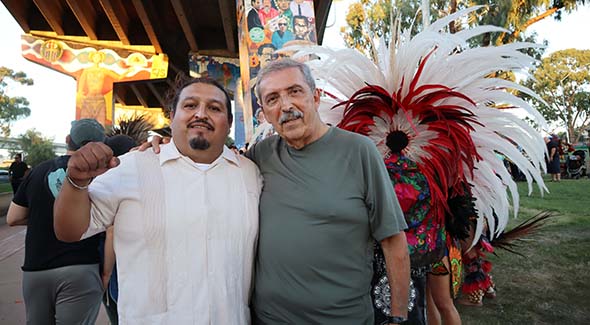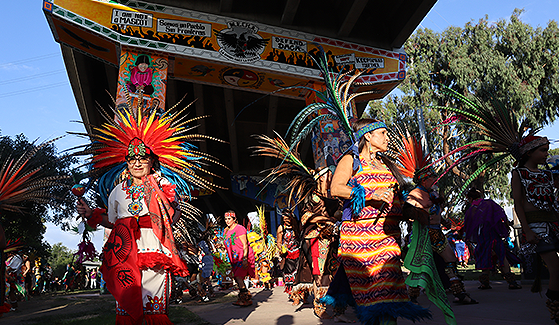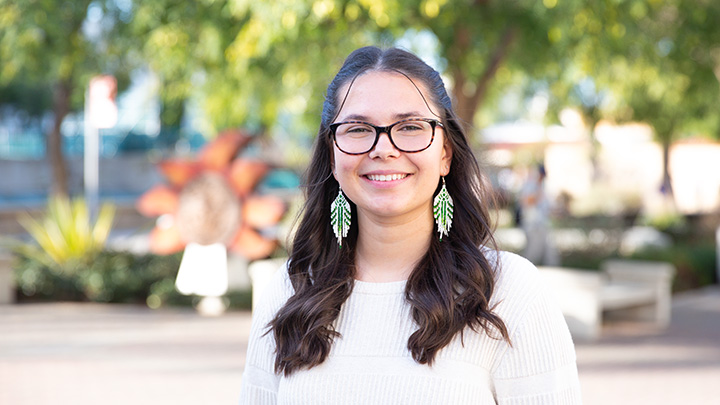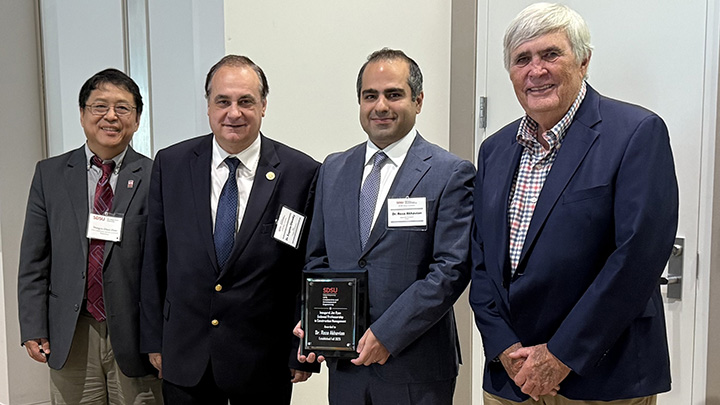Alumnus Unveils a Chicano Park Mural, 20 Years in the Making
Jose Olagues National M.E.Ch.A. mural prominently features San Diego State University faculty and alumni.

The smell of burning sage, the rhythmic thunder of drums and the kinetic blur of brightly adorned Aztec dancers heralded the completion of a new masterpiece at San Diego’s iconic Chicano Park.
The lively festivities on Sept. 3 were part of the unveiling of a mural by the national Chicano student organization, M.E.Ch.A. (Movimiento Estudiantil Chicano de Aztlán). The massive piece is a two-decade labor of love undertaken by San Diego State University alumnus and proud former MEChista Jose Olague (’04, ’10).
Located prominently in the southeastern part of the Barrio Logan park — a National Historic Landmark that features the largest collection of Chicano murals in the world, mostly painted on freeway columns — Olague’s vibrant work depicts key figures and events in the struggle for Chicano and Indigenous rights, as well as the history of the M.E.Ch.A. student movement on college campuses.
“I wanted this mural to tell the truth about who we are,” said Olague. “There's always been resistance. There have always been different perspectives.”
Growing up in San Diego, Olague became interested in art as a youth through lowrider culture. He was never formally trained as an artist, but he immersed himself in Indigenous artwork and symbolism through his involvement in M.E.Ch.A. as a student in high school and college.
Olague began painting the pillars in 2003 while majoring in social science and Chicano studies at SDSU. Now a teacher in San Diego’s South Bay, he finished the sprawling project on his summer vacation with the help of a team of 60 volunteers, more than three-quarters of them Chicana artists.

Chicano Leaders
It’s a work emblazoned with SDSU history. Protest slogans adorn the west-facing pillar, including “I am NOT a MASCOT” next to an image of the now-retired Monty Montezuma logo — a nod to M.E.Ch.A. and Native American Student Alliance activism that implored the university to change its representation of Aztec culture.
And two-thirds of the way up the southwest column is a tribute to SDSU educators who were key figures in the Chicano rights movement.
Near the top is the late Rene Nuñez, professor emeritus of Chicana and Chicano Studies. One of the organizers of the 1969 conference that produced “El Plan de Santa Bárbara: A Chicano Plan for Higher Education” and birthed M.E.Ch.A., Nuñez would later help develop SDSU’s Chicana and Chicano studies curriculum.
On the row below is Alberto Ochoa, professor emeritus in Education. Ochoa is a founding faculty member and later chair of what is now SDSU’s Department of Dual Language and English Learner Education (DLE), California’s largest producer of bilingual teachers.
Immediately to the left is Isidro Ortiz, professor and former chair in Chicana and Chicano Studies, who is a longtime advisor to SDSU’s chapter of M.E.Ch.A.
On the next row down in a red shirt is Jesús Nieto, associate professor emeritus in the School of Teacher Education. Nieto, who taught multicultural education at SDSU, served as M.E.Ch.A.’s campus advisor for 25 years.
Also on the north interior is Mario Aguilar, a University of California San Diego professor emeritus and lecturer in SDSU’s Department of Chicana and Chicano Studies. The SDSU triple alumnus is captain of the Danza Mexi'cayotl traditional Chicano dance circle, which performed at the unveiling.
“They've always been involved, always been out there with different organizations working to improve conditions in our communities,” said Olague, who earned his teaching credential and master’s degree from SDSU’s DLE program. “It's time for them to be recognized. These are the examples that we need in our community.”
Surprise and Gratitude
Ochoa, Ortiz, Nieto and Aguilar were all on hand for the unveiling. Ortiz delivered remarks about the significance of SDSU’s M.E.Ch.A. chapter, which he lauded for its recent push to create the university’s Latinx Resource Center and Undocumented Resource Center.
“We’ve now had four generations of MEChistas (at SDSU),” Ortiz said to the assembled crowd. “It’s changed over time, but the one continuity has been the struggle by these students for justice and for equality in higher education — and that, to me, is very inspiring.”
Ochoa and Nieto well remember Olague from his time in SDSU’s graduate education programs, both as a star student and a stellar artist. Neither knew they would be depicted in the mural until word started to leak out on social media.
“I’m honored and I feel a lot of gratitude,” Ochoa said. “But it’s also recognizing the constellation of people who are working, not as individuals but collectively, to bring about change in terms of the promise of an equal educational opportunity and the right to equal representation.”
Said Nieto: “When I found out about it about six weeks ago, I was just speechless. Today has lived up to everything I hoped.”



